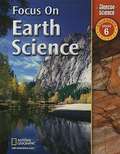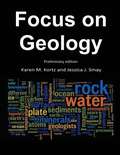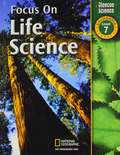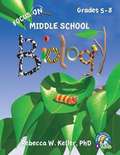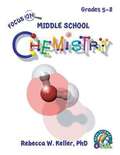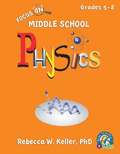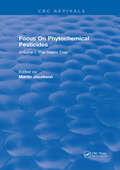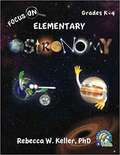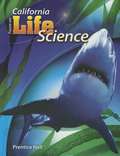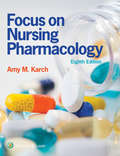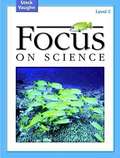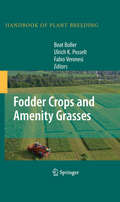- Table View
- List View
Focus On Earth Science (California)
by Douglas Fisher Dinah Zike National Geographic Donna L. Ross Elizabeth A. Nagy-Shadman Jan Vermilye Joseph J. Kerski Juli Berwald Julie Meyer Sheets Nancy Trautmann Sergio A. GuazzottiNIMAC-sourced textbook
Focus On Geology Preliminary Edition
by Karen Kortz Jessica SmayThis Physical Geology textbook uses cutting edge research to guide the creation of carefully structured pages that cover topics commonly taught in introductory physical geology courses. The book is focused around images and emphasizes the key concepts Research (e.g. Mayer, 2003) indicates that students learn more deeply: - when extraneous material is excluded rather than included, - from words and pictures than from words alone, - when printed words are placed near rather than far from corresponding pictures, and - when words are presented in conversational rather than formal style. Most traditional geoscience textbooks do not address this research. Although geoscience textbooks are image-rich, the text is often separate from figures, generally with a note in the text referring the student to look at the image. Research indicates that many students just glance at the images or ignore them altogether, resulting in a less productive learning experience than intended by the authors. Also, most textbooks, even "essentials" versions, tend to have more information than an introductory student can learn in a semester, and the students, therefore, have a difficult time distilling the key concepts from the details. Images play an integral role in the textbook. There are no long blocks of text to read, but, instead, most information is presented incorporated in or around figures. Students therefore examine the images, integrating text and figures, which results in a deeper learning experience. Concepts are represented in multiple ways (photographs, written descriptions, detailed drawings, sketches, graphs, analogies, etc.) to maximize student learning. Because research indicates that students have a difficult time pulling out the key points from images, many of the images in this book are simple, without too many realistic-but-distracting details. Many of the photographs are accompanied by a simplified sketch of the same area illustrating the important geological features shown. The process of comparing two images presenting the same information in different ways (e.g. a photograph and a sketch) directs students to observe the important features and requires students to integrate those two images, strengthening their learning. Simple language is used when writing, and non-essential vocabulary words are omitted, so students will not focus on memorizing definitions without understanding the concepts. The book has a more conversational style than many current textbooks. This textbook presents the key concepts in geoscience without additional distracting details. As a result, this book is shorter than other books currently on the market. The concise nature of the book encourages students to read it. Because it emphasizes the key concepts, students have a better understanding of the fundamentals and will come to class more prepared. Therefore, instructors will be able to cover additional information in class, because the fundamentals are already understood by the students. The themes in the book are plate tectonics, water cycle, rock cycle and how geology and people affect each other. These are concepts that are key in understanding geoology and learning why it is relevant in today's society. These three themes are emphasized, and individual topics are related back to the overarching themes.
Focus On Life Science (California)
by Douglas Fisher Dinah Zike National Geographic Donna L. Ross Juli Berwald Keith Olin Mann Kimberly Fekany LeeNIMAC-sourced textbook
Focus On Middle School Biology
by Rebecca W. KellerThe Focus On Middle School Biology Student Textbook gives young students a strong foundation in the scientific discipline of biology. Students will learn about the classification of living things (taxonomy), cell structure and types of cells, photosynthesis, plant structures and their purpose, the life cycle of plants, single-celled organisms and how they move and eat, the life cycle of the frog, the life cycle of the butterfly, and ecosystems. The Focus On Middle School Biology Student Textbook contains 10 full-color chapters. Grades 5-8.
Focus On Middle School Biology Student Textbook, 3rd Edition (Real Science-4-kids Ser.)
by Rebecca W. KellerThe Focus On Middle School Biology Student Textbook, 3rd Edition introduces young students to the scientific discipline of biology. Students will learn about philosophical maps, taxonomy, tools used in biology labs and fieldwork, microscopes, the chemistry of living things, the different types of cells, viruses, bacteria, archaea, protists, fungi, plant structures and reproduction, photosynthesis, animal cells and structures, non-chordates, mammals and other chordates, human anatomy, and more. The Focus On Middle School Biology Student Textbook, 3rd Edition has 16 full-color chapters and a glossary-index with pronunciation guides. 214 pages. Grades 5-8.
Focus On Middle School Chemistry
by Rebecca W. KellerThe Focus On Middle School Chemistry Student Textbook provides young students with a solid foundation in the concepts of the scientific discipline of chemistry. Students will learn about atoms, how atoms bond to form molecules, types of bonds, chemical reactions, acids and bases, pH, mixtures and how they can be separated, energy molecules in food, polymers and their characteristics, DNA, proteins, and more. The Focus On Middle School Chemistry Student Textbook has 10 full-color chapters. Grades 5-8.
Focus On Middle School Physics (Grades 5-8)
by Rebecca W. KellerThe Focus On Middle School Physics Student Textbook provides students with a solid foundation in the scientific discipline of physics. Students will learn about concepts such as force, work, potential and kinetic energy, motion, energy of atoms and molecules, electrical energy, moving electric charges, magnets, light and sound, the conservation of energy, and more. The Focus On Middle School Physics Student Textbook has ten full-color chapters and includes a glossary and pronunciation guide at the back of the book. Grades 5-8.
Focus On Physical Science (California)
by Douglas Fisher Dinah Zike Laurel Dingrando Margaret K. Zorn National Geographic Cindy Klevickis David G. Haase Isaac Turiel Jennifer GonyaNIMAC-sourced textbook
Focus On Phytochemical Pesticides
by Martin JacobsonFirst published in 1989. Presents research and findings from a series of conferences in the 1980s on the use of plants in pesticides for insect control.
Focus on California Earth Science
by PearsonTextbook for California schoolchildren on earth systems and processes, plate tectonics and earth's structure, weather and climate, and ecology and resources.
Focus on Earth Science: Reading and Note Taking Guide Level B (California Edition)
by Pearson EducationThis Reading and Note Taking Guide helps your students succeed in their study of science. Working through the exercises will help them understand and organize the concepts presented in the textbook. The completed worksheets then become easy-to-follow study guides for test preparation. It also helps students improve their study and reading skills.
Focus on Earth Science: Reading and Note Taking Guide, Level A (California Edition)
by Pearson EducationThis Reading and Note Taking Guide helps your students succeed in their study of science. Working through the exercises will help them understand and organize the concepts presented in the textbook.
Focus on Elementary Astronomy Student Textbook
by Rebecca W. KellerThe Focus On Elementary Astronomy Student Textbook introduces young students to the scientific discipline of astronomy. Students will learn about the history of astronomy, the telescope, the Moon and the Sun and their effects on Earth, solar and lunar eclipses, planets and their characteristics, our solar system, neighboring stars, our Milky Way Galaxy, other galaxies, comets, asteroids, nebulae, other objects in space, and more.The Focus On Elementary Astronomy Student Textbook has ten full-color chapters. Grades K-4.
Focus on Life Science (California Edition)
by Pearson Prentice HallThis textbook is organized to support students learning of the California Science Content Standards, understanding this organization can help students master the standards provided in the book. Every chapter begins with a Focus on the Big Idea question that is linked to a California Science Standard. Focus on the Big Idea poses a question for students to think about as they study the chapters. They will discover the answers to the question as they read.
Focus on Life Science (California Edition, Grade #7)
by Donald FisherLearn more about the science of living things in this interesting textbook.
Focus on Nursing Pharmacology (Coursepoint+)
by Amy M. KarchMaster the Principles of Effective Drug Therapy Current, concise, and optimized for today’s nursing practice, Focus on Nursing Pharmacology makes challenging concepts more approachable to establish a foundation for effective drug therapy throughout your nursing career. This updated 8th edition builds on your knowledge of physiology, chemistry and nursing fundamentals to help you conceptualize need-to-know information about each group of drugs, while engaging learning features cultivate your clinical application, critical thinking and patient education capabilities. NEW! Concept Mastery Alerts alert you to commonly misunderstood concepts. NEW! Unfolding case-based vignettes written by the National League for Nursing bring concepts to life through realistic clinical scenarios. Concise, streamlined approach emphasizes need-to-know information for efficient learning. Nursing Processes clarify the process for planning patient-centered care. Critical Thinking Scenarios guide you through the collection and application of data for commonly encountered clinical interactions. Nursing Considerations sections detail the rationale behind each nursing intervention to enhance your clinical decision-making capabilities. Drug Lists at the beginning of each chapter enable fast identification of prototype drugs for each class. Drugs in Focus tables provide at-a-glance reference for generic and trade names, usual dosage and indications for each drug within a class. Focus on Safe Medication Administration boxes help you ensure patient safety and increase the therapeutic effectiveness of drugs. Focus on the Evidence boxes identify the best nursing practices associated with specific drugs based on available evidence. Focus on Herbal and Alternative Therapies alert you to known interactions with specific herbs or alternative therapies that could affect drug actions. Focus on Calculations refine your calculation and measurement skills. Focus on Drug Therapy Across the Lifespan boxes provide quick access to drug class considerations for use with children, adults and the elderly. Focus on Gender Considerations and Focus on Cultural Considerations help you ensure effective, culturally sensitive drug therapy across diverse populations. Check Your Understanding sections equip you for your exams with NCLEX®-style review questions, including alternate-format questions. Watch and Learn videos available on thePoint® help you avoid medication errors in practice.
Focus on Physical Science
by Jack Price Charles H. HeimlerFocus on Physical Science is a practical study of the relationship between matter and energy. Fundamental Physical Science principles are introduced through student involvement rather than by rote memorization. This book comprises seven units, the contents of which include Measurement and Motion, Classification of Matter, Patterns in Matter, Changes in Matter, Light and Sound, Energy, Energy Resources for the Future. Units of Measurement and Laboratory Techniques form part of Appendix.
Focus on Physical Science (California Edition)
by T. Griffith Jones David V. Frank John G. Little et. alEvery chapter begins with a Focus on the Big Idea question that is linked to a California Science Standard. It also promotes active reading and enhances student note taking skills, and gives teachers a useful tool in guiding the students to study and learn. Each chapter is organized into nine general standard sets which are Motion, Forces, Structure of Matter, Earth in the Solar System, Reactions, Chemistry of Living Systems, Periodic Table, Density and Buoyancy, and Investigation and Experimentation.
Focus on Science, Level C
by Steck-VaughnJust like you, these animals have grow a lot. At one time, they were too small to see! These animals are still growing. In time, they will be as big as their mother. Then, they will be able to have babies of their own. In this unit you will learn how living things grow and change during their lives. You will also learn how to keep healthy as your own body grows and changes.
Focused Ion Beam Systems
by Nan YaoThe focused ion beam (FIB) system is an important tool for understanding and manipulating the structure of materials at the nanoscale. Combining this system with an electron beam creates a DualBeam - a single system that can function as an imaging, analytical and sample modification tool. Presenting the principles, capabilities, challenges and applications of the FIB technique, this edited volume comprehensively covers the ion beam technology including the DualBeam. The basic principles of ion beam and two-beam systems, their interaction with materials, etching and deposition are all covered, as well as in situ materials characterization, sample preparation, three-dimensional reconstruction and applications in biomaterials and nanotechnology. With nanostructured materials becoming increasingly important in micromechanical, electronic and magnetic devices, this self-contained review of the range of ion beam methods, their advantages, and when best to implement them is a valuable resource for researchers in materials science, electrical engineering and nanotechnology.
Fodder Crops and Amenity Grasses
by Fabio Veronesi Ulrich K. Posselt Beat BollerThe main role of grasses, clovers and alfalfa in temperate agriculture is still to provide forage for ruminant animals but, in the last decades, the importance of amenity grasses increased markedly and, in the near future, new developments in the areas of energy and biomass use can be envisaged. Fodder Crops and Amenity Grasses, fifth volume in the series, Handbook of Plant Breeding, covers all these aspects. Most fodder crops and amenity grasses are perennials and many of them are natural or induced polyploids. Thus, breeding procedures and strategies differ greatly from breeding annual field crops. Breeding objectives are more difficult to define in forage crops because direct measurement of the efficiency of animal production during breeding and variety assessment is impractical. As a result, a large number of selection criteria have been developed for the particular crops. However, breeding objectives and methodology have a common basis among these species and are therefore presented in the general chapters. Particular emphasis is placed on the breeding methodology for cross-pollinating species because the large majority of crops belong to this group. In addition, the potential of new molecular techniques to complement breeding concepts and strategies is presented and critically discussed. Special techniques and procedures as well as particular breeding goals will be included in the crop specific chapters. Amenity grass breeding has its own breeding objectives and testing procedures, however, the species are mostly the same as in forage grass breeding, and crop specific chapters will include the amenity aspects where appropriate. The crop specific chapters will cover the range of topics given in the guidelines below. The volume on Fodder Crops and Amenity Grasses is the fifth volume in series Handbook of Plant Breeding after the initial volumes on Vegetables, Cereals, Oil Crops and Fruits. Like the other volumes in the series, the volume presents information on the latest scientific information in applied plant breeding using the current advances in the field, from efficient use of genetic resources to impact of biotechnology in plant breeding. Outstanding scientists from all over the world have contributed chapters to the work.
